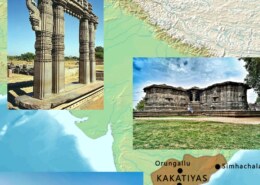Talk about the claim that “Yoga is a complex art form that harmonizes the mind, body, and soul” rather than just a physical type of exercise. Consider its cultural significance as a spiritual and health-promoting activity in India and globally.
The Kakatiya dynasty, which ruled parts of present-day Telangana and Andhra Pradesh in India from the 12th to the 14th centuries, is renowned for its contributions to architecture and literature. Architecture The Kakatiya dynasty is celebrated for its architectural achievements, especially the constRead more
The Kakatiya dynasty, which ruled parts of present-day Telangana and Andhra Pradesh in India from the 12th to the 14th centuries, is renowned for its contributions to architecture and literature.
Architecture
The Kakatiya dynasty is celebrated for its architectural achievements, especially the construction of temples and forts that display intricate craftsmanship and innovative engineering.
- Ramappa Temple (Rudreshwara Temple):
- Location: Palampet, near Warangal
- Construction: Begun in 1213 AD, during the reign of King Ganapati Deva and completed by his daughter Rudrama Devi
- Features: The temple is known for its star-shaped platform, intricate carvings, and floating bricks used in the construction of the roof. The pillars and ceilings are adorned with elaborate sculptures depicting scenes from Hindu mythology.
- Thousand Pillar Temple:
- Location: Hanamakonda, Warangal
- Construction: Built during the reign of King Rudra Deva in the 12th century
- Features: As the name suggests, the temple complex is known for its thousand intricately carved pillars, three shrines dedicated to Shiva, Vishnu, and Surya, and detailed carvings of elephants and other figures.
- Warangal Fort:
- Location: Warangal
- Construction: Initiated by King Ganapati Deva and expanded by his successors
- Features: The fort is famous for its massive stone gateways, known as Kakatiya Kala Thoranam, and its defensive structures. The four ornamental gates are a symbol of the Kakatiya dynasty’s architectural prowess and are now part of the state emblem of Telangana.
Literature
The Kakatiya period also saw significant literary contributions, with patronage extended to poets, scholars, and writers.
- Prataparudra Charitramu by Ekamranatha:
- Content: This work is a historical account of the reign of Prataparudra II, the last Kakatiya king. It provides valuable insights into the administration, culture, and socio-political conditions of the Kakatiya period.
- Ranganatha Ramayanam by Gona Budda Reddy:
- Content: This Telugu version of the Ramayana is notable for its lyrical beauty and adaptation of the epic to local culture and traditions. It played a crucial role in popularizing the Ramayana story among the Telugu-speaking population.
- Nritta Ratnavali by Jayapa Senani:
- Content: This treatise on dance and music is considered one of the earliest comprehensive works on the subject in Telugu. It provides detailed descriptions of various dance forms, musical instruments, and performance techniques prevalent during the Kakatiya period


The word “yoga” is derived from the Sanskrit word “Yuj,” meaning union or to join. The roots of yoga can be traced back over 5,000 years to ancient India and it is based on the 196 Yoga Sūtras of Patañjali. It embodies the philosophy of harmonizing the mind, body, and spirit through physical postureRead more
The word “yoga” is derived from the Sanskrit word “Yuj,” meaning union or to join. The roots of yoga can be traced back over 5,000 years to ancient India and it is based on the 196 Yoga Sūtras of Patañjali. It embodies the philosophy of harmonizing the mind, body, and spirit through physical postures, breath control, meditation, and ethical principles.
Yoga as a Form of Physical Exercise:
- Flexibility: The practice of yoga involves various asanas like Downward Dog and Warrior II, which are not merely static postures but dynamic exercises. These poses stretch multiple muscle groups, leading to improved flexibility.
- Strength: Yoga is highly effective in building core strength. Poses like Plank and Crow Pose require maintaining a challenging position for an extended period, thus engaging and strengthening core muscles without the intense wear and tear that weight lifting can cause.
- Balance: Yoga poses like Tree Pose and Eagle Pose are designed to fine-tune the body’s sense of balance. Achieving balance in these poses requires harmony between mind and body, enhancing spatial orientation skills.
- Endurance: The Surya Namaskar, or Sun Salutation, is a sequence of twelve postures challenging different muscle groups. Practicing this sequence repeatedly builds physical stamina and endurance as it requires sustained energy to perform.
- Pain Relief: Certain yoga poses like Child’s Pose and Pigeon Pose are therapeutic by nature. They focus on stretching and releasing tension from problem areas, such as the lower back and hips, offering relief from chronic pain conditions.
- Cardiovascular Health: Anulom Vilom and other Pranayama exercises improve cardiovascular health by regulating the breath and enhancing oxygen supply to the blood. These breathing exercises work on the cardiovascular system, leading to lower blood pressure and a healthier heart.
See less